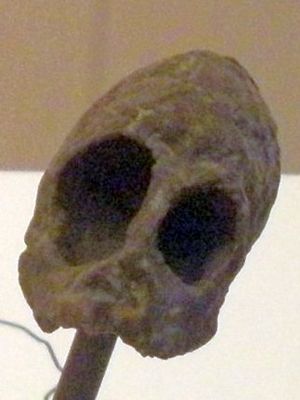Dolichocebus facts for kids
Quick facts for kids Dolichocebus |
|
|---|---|
 |
|
| Skull AMNH | |
| Scientific classification | |
| Genus: |
Dolichocebus
|
| Species: |
gaimanensis
|
Dolichocebus is an extinct New World monkey that lived a very long time ago. It was a type of monkey that lived in what is now Patagonia in Argentina. Scientists believe it lived about 21 to 17.5 million years ago. This time period is called the Miocene epoch. The first Dolichocebus fossil found was named D. gaimanensis.
Contents
What Was Dolichocebus?
Dolichocebus was a genus of ancient monkeys. A genus is a group of very similar animals. This monkey is called a "New World monkey" because it lived in the Americas. New World monkeys are different from "Old World monkeys" (which live in Africa and Asia). They have wider noses and often have tails that can grip things like branches.
A Glimpse into the Past
This ancient monkey lived during the Early Miocene epoch. That's a really long time ago! To give you an idea, dinosaurs were already gone for millions of years before Dolichocebus appeared. Scientists learn about these animals by studying their fossils. Fossils are the preserved remains or traces of plants and animals from long ago.
What Did It Look Like?
We know about Dolichocebus mainly from its skull. The skull shown in the picture gives us clues about its size and features. Based on its skull, scientists think Dolichocebus was probably a small to medium-sized monkey. It likely had a long tail, like many New World monkeys today. Its teeth would tell us what kind of food it ate. Most likely, it ate fruits, leaves, and insects, just like many modern monkeys.
Its Ancient Home
Dolichocebus lived in a place called the Sarmiento Formation in Argentine Patagonia. Today, Patagonia is known for its wide-open spaces and unique wildlife. Millions of years ago, during the Miocene, the environment might have been different. It could have been warmer and had more forests, providing a good home for monkeys. These monkeys would have lived in trees, using their agility to move through the branches.
Why Are Fossils Important?
Finding fossils of animals like Dolichocebus is very important. They help scientists understand how life on Earth has changed over millions of years. By studying these fossils, we can learn:
- How different animal groups evolved.
- What ancient environments were like.
- How animals spread across continents.
- The connections between extinct animals and the animals we see today.
Dolichocebus helps us understand the early history of monkeys in South America. It shows us that many different kinds of monkeys lived there long ago.
See also
 In Spanish: Dolichocebus gaimanensis para niños
In Spanish: Dolichocebus gaimanensis para niños

